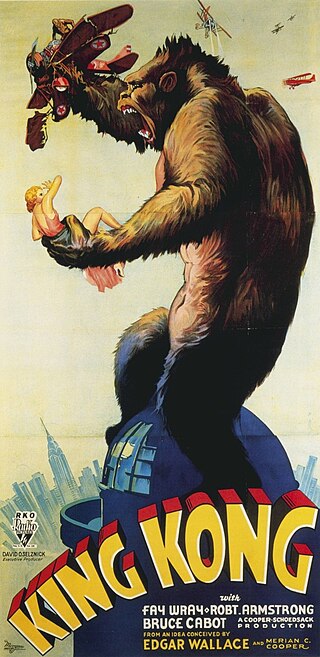
King Kong is a 1933 American pre-Code adventure monster film directed and produced by Merian C. Cooper and Ernest B. Schoedsack, with special effects by Willis H. O'Brien. Produced and distributed by RKO Radio Pictures, it is the first film in the King Kong franchise. The film stars Fay Wray, Robert Armstrong and Bruce Cabot. In the film, a giant ape dubbed King Kong captured from Skull Island attempts to possess a beautiful young woman.

The Haunting is a 1963 British horror film directed and produced by Robert Wise, adapted by Nelson Gidding from Shirley Jackson's 1959 novel The Haunting of Hill House. It stars Julie Harris, Claire Bloom, Richard Johnson, and Russ Tamblyn. The film depicts the experiences of a small group of people invited by a paranormal investigator to investigate a purportedly haunted house.

Night Monster is a 1942 American black-and-white horror film featuring Bela Lugosi and produced and distributed by Universal Pictures Company. The movie uses an original story and screenplay by Clarence Upson Young and was produced and directed by Ford Beebe. For box office value, star billing was given to Bela Lugosi and Lionel Atwill, but the lead roles were played by Ralph Morgan, Irene Hervey and Don Porter, with Atwill in a character role as a pompous doctor who becomes a victim to the title character, and Lugosi in a small part as a butler.
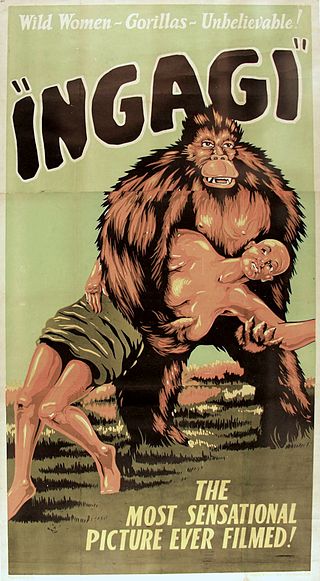
Ingagi is a 1930 pre-Code pseudo-documentary exploitation film directed by William S. Campbell. It purports to be a documentary about "Sir Hubert Winstead" of London on an expedition to the Belgian Congo, and depicts a tribe of gorilla-worshipping women encountered by the explorer. The film claims to show a ritual in which African women are given over to gorillas as sex slaves, but in actuality was mostly filmed in Los Angeles, using American actresses in place of natives. It was produced and distributed by Nat Spitzer's Congo Pictures, which had been formed expressly for this production. Although marketed under the pretense of being ethnographic, the premise was a fabrication, leading the Motion Picture Producers and Distributors Association to retract any involvement.

Blackenstein is a 1973 American blaxploitation horror film directed by William A. Levey, and starring John Hart, Ivory Stone, Andrea King, Roosevelt Jackson, Joe De Sue, Nick Bolin and Liz Renay. It is loosely based on Mary Shelley's 1818 novel Frankenstein; or, The Modern Prometheus. Released on August 3, 1973, it was made in an attempt to cash in on the success of Blacula; released the previous year by American International Pictures. However, Blackenstein fared poorly in comparison to its predecessor, with most reviews agreeing that the film was "a totally inept mixture of the worst horror and blaxploitation films".
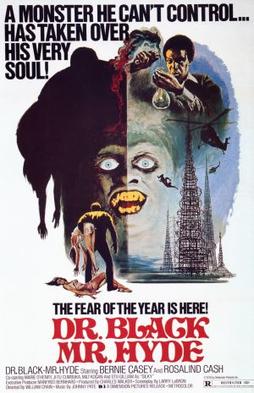
Dr. Black, Mr. Hyde is a 1976 blaxploitation horror film loosely inspired by the 1886 novella Strange Case of Dr. Jekyll and Mr. Hyde by Robert Louis Stevenson. The film stars Bernie Casey and Rosalind Cash, and was directed by William Crain. Along with Crain, and it was written by Larry LeBron and Lawrence Woolner with cinematography by Tak Fujimoto. It was filmed primarily in Los Angeles, at locations such as the Watts Towers.

Severance is a 2006 comedy horror film co-written and directed by Christopher Smith. Co-written with James Moran, it stars Danny Dyer and Laura Harris. The film tells a story of group of British and Canadian co-workers who go to a remote mountain forest in Hungary, where they become victims of murderous attacks by a group of poachers.

Lighthouse is a 1999 British horror film directed by Simon Hunter. The film follows survivors of a shipwreck being preyed on by an escaped psychotic convict who beheads his victims. It was shot in Cornwall for the main locations, and Hastings in East Sussex.

Mildred Mosler Weisenfeld is the Brooklyn-born founder of national not-for-profit foundation the National Council to Combat Blindness in 1946, now known as Fight for Sight, an organization based in New York City that provides initial funds to promising scientists early in their careers. For 50 years, Weisenfeld was a one-woman campaign to increase funding for eye research, despite losing her own vision and having no scientific training.
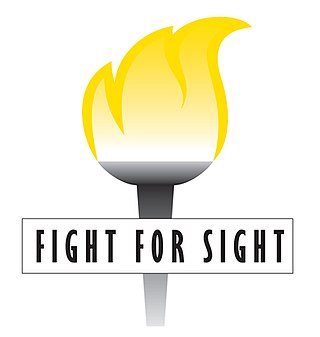
Fight for Sight is a nonprofit organization in the United States which funds medical research in vision and ophthalmology. It was formed in 1946 as the National Council to Combat Blindness (NCCB), the first non-profit organization in the United States to fund vision research; 2011 marked its 65th anniversary.

Mischief Night is a 2013 American horror film written and directed by Richard Schenkman. It focuses on a young girl with psychosomatic blindness being terrorized by a hooded killer.

House of the Damned is a 1963 horror thriller film, shot in CinemaScope. It was produced and directed by Maury Dexter, and stars Ron Foster, Merry Anders, Richard Crane, Erika Peters and Richard Kiel.
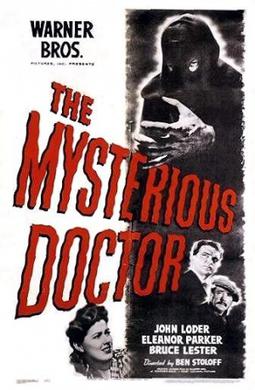
The Mysterious Doctor is a 1943 American horror film directed by Benjamin Stoloff and written by Richard Weil. The film stars John Loder, Eleanor Parker, Bruce Lester, Lester Matthews and Forrester Harvey. The film was released by Warner Bros. on March 3, 1943.














